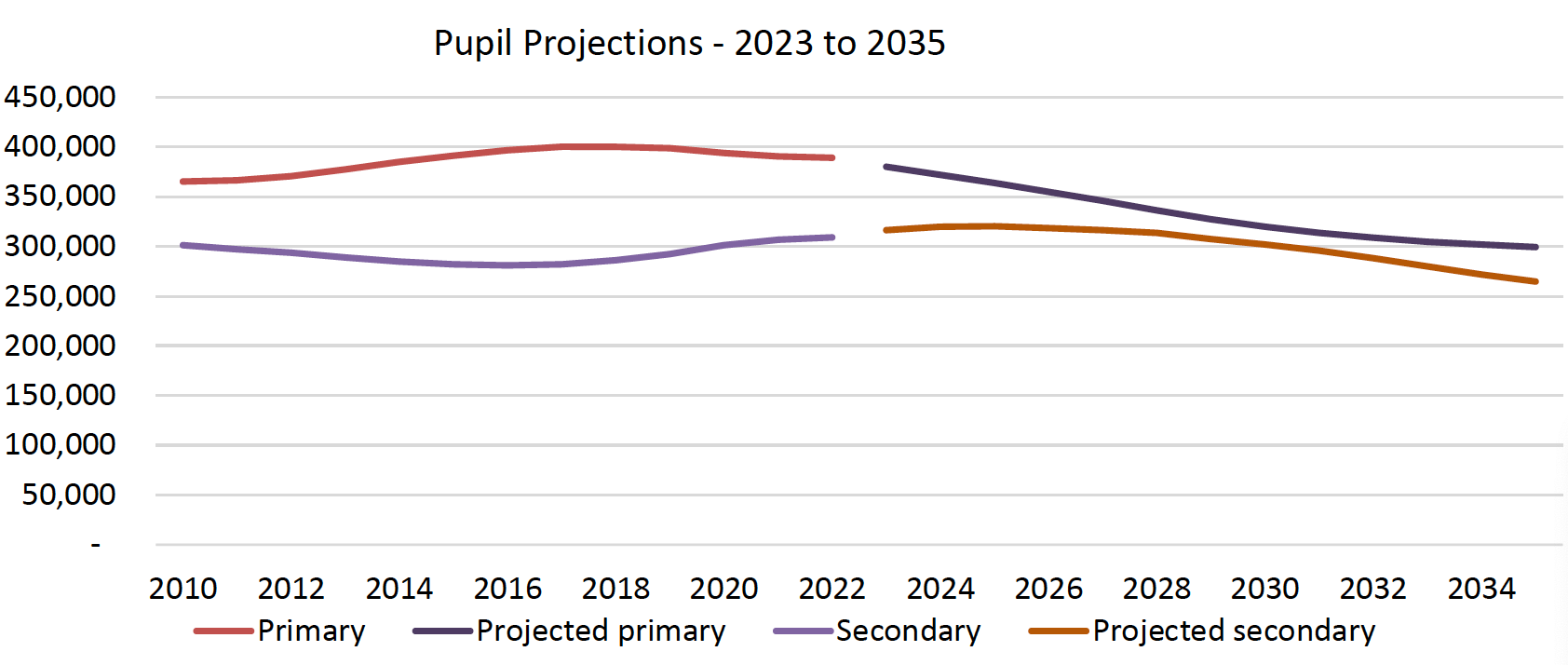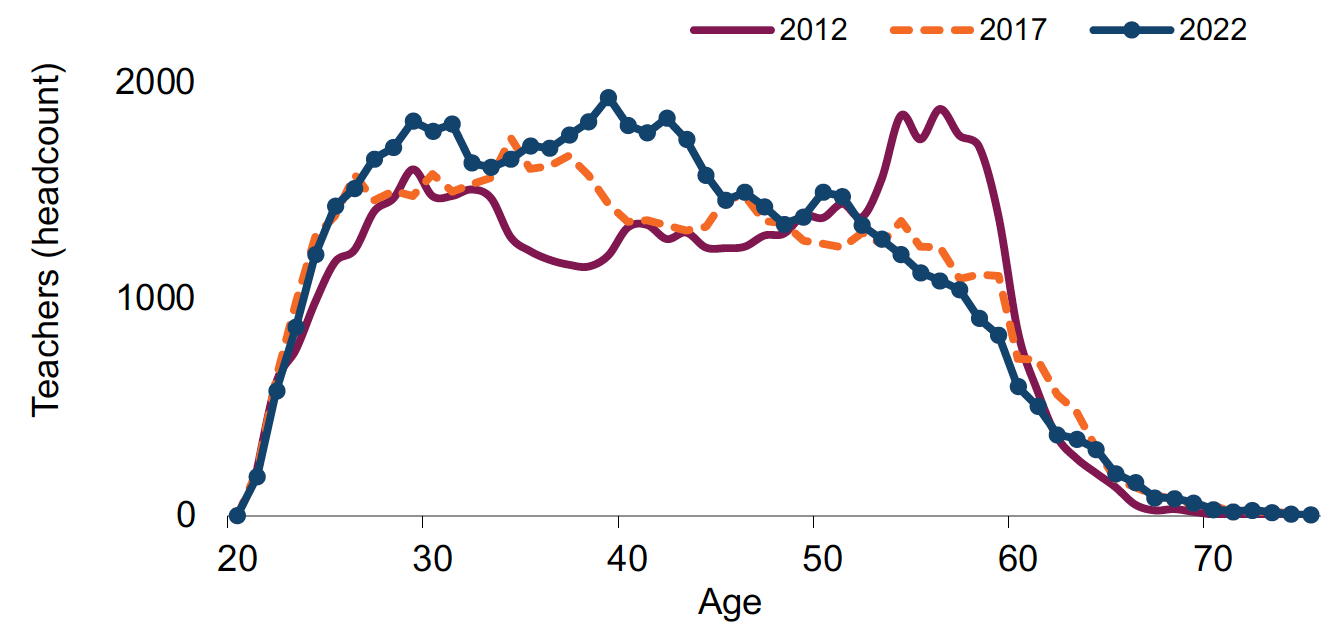Teacher Workforce Planning - 2023 exercise - Statistical modelling paper
Teacher Workforce Planning Advisory Group - Statistical modelling paper 2023
Teacher workforce planning 2023 Exercise – November 2023 Statistical Model
The teacher workforce planning model estimates future student teacher intake numbers by rolling forward recent patterns in the school pupil and staff censuses and other data including national population projections.
The modelling described here uses the most recent data available i.e. the 2022 school pupil and staff censuses and the 2020-based national population projections (updated by ONS in January 2023 to take account of higher inward migration than previously thought). It is based on a set of assumptions - other assumptions would result in different estimates.
1. Modelling approach
The workforce planning model is based on the aim of calculating the initial teacher education (ITE) student intake required for maintaining the 2022 teacher numbers across each sector. With pupil numbers projected to fall overall by 2025, this will lead to a decrease in PTRs.
Model Inputs
1.1. Pupil projections

The primary school roll has been falling since reaching a peak in 2017. Pupil projections based on population projections from National Records of Scotland show the number of primary pupils continuing to decrease through to 2035.
At secondary level, the pupil roll increased in 2017 for the first time in 14 years and is projected to continue increasing until 2024, after which it will fall below current levels by the end of the projection period in 2035.
These projections are based on the 2020 population projections which, following the recent fall in births, assume a lower birth rate than previous projections. An update to the 2020 population projections was published in January 2023 to account for higher than expected inward migration. This mainly affected young adult age groups with a lagged effect on school-aged children projections. Pupil projections based on cohorts that were not yet born are less reliable than projections for earlier years (beyond 2026 for Primary and 2032 for Secondary).
1.2. Teacher Numbers
In the past 5 years we have seen a rise in teacher numbers of nearly 2,700 (a 5% increase). There have been increases across both the primary and secondary sectors. The 4% increase in primary teachers (compared to the 3% decrease in pupils) has meant that there are fewer pupils per teacher and consequently the primary pupil teacher ratio (PTR) has decreased to the second lowest ever level (primary teacher numbers were higher in 2021 than in 2022). However, in secondary schools the number of pupils grew at a faster rate (10%) than the number of teachers (7%), meaning there were more pupils per teacher. The result of this is that the secondary PTR is now close to the highest level since 2004.
| Primary | Secondary | Total | |
|---|---|---|---|
| 2017-2022 | 4% | 7% | 5% |
*Total change across this period includes centrally employed teachers and ELC teachers, both of which have decreased.
Data source: Teacher census supplementary statistics 2022
1.3. Age profiles of teachers
The 2022 Teacher Census data shows that the age profile of teachers has changed much over the past 10 years. The prominent peak of teachers in their mid to late-fifties, as seen in 2012, no longer exists. Teacher numbers are now relatively consistent from age 25 to 40 and slowly reduce in the older age groups.

Data source: Teacher census supplementary statistics 2022
1.4. Wastage Rates (Excluding probationers)
The wastage rates used in the modelling are based on an average of the past five years’ figures. They represent the sum of all reductions in existing teacher FTE as a proportion of total teacher FTE. Higher rates for women under 40 include maternity leave, whilst higher rates for those from their late 50s reflect retirement (both full and partial).

Total projected 2022 primary wastage – 3,400 FTE

Total projected 2022 secondary wastage – 2,600 FTE
1.5. Returners
The returner numbers used in the modelling are based on an average of five years’ data. They represent the sum of all increases in FTE (this includes new teachers as well as teachers increasing their hours). Numbers are used instead of rates for returners since as we do not have details of the pool of non-working teachers in any year.
The average of the last five years’ figures have been used for Primary (2,300) and secondary (1,800).
1.6. Working patterns
There has been a steady increase in the proportion of teachers working part time over recent years up to 24.0% in 2019. This decreased slightly in 2020 to 23.4% but rebounded to 24.5% in 2022. The overall move to part time working has been accounted for in the model within the wastage and returners assumptions.
| Full time | Part time | Total Headcount | Percentage part time | |
|---|---|---|---|---|
| 2017 | 43,016 | 12,693 | 55,709 | 22.8 |
| 2018 | 43,198 | 13,265 | 56,463 | 23.5 |
| 2019 | 43,246 | 13,620 | 56,866 | 24.0 |
| 2020 | 44,387 | 13,564 | 57,951 | 23.4 |
| 2021 | 45,006 | 13,924 | 58,930 | 23.6 |
| 2022 | ||||
| Primary | 19,926 | 9,113 | 29,039 | 31.4 |
| Secondary | 21,887 | 4,705 | 26,592 | 17.7 |
| Special | 1,704 | 656 | 2,360 | 27.8 |
| Centrally | ||||
| Employed | 747 | 585 | 1,332 | 43.9 |
| Total | 44,493 | 14,419 | 58,912 | 24.5 |
1.7. Teacher Induction Scheme (TIS) Wastage rates
Teacher Induction Scheme wastage rates are based on an average of the last 5 years of data. These rates calculate the percentage reduction in FTE of TIS teachers in the year following their probation year.
Primary – 27%
Secondary – 18%
1.8. Retention rates
Retention rates (ITE students who go on to the Teacher Induction Scheme) vary between the route used for ITE study. Retention rates for primary undergraduate and PGDE courses are around 75% and 90% respectively. Rates for Secondary courses are around 60% (Undergraduate including combined degrees) and 80% (PGDE).
We measure retention rates as a proportion of those leaving university to those starting the teacher induction scheme. Probationers who chose the flexible route are not captured in these retention rates, but are captured in the model amongst the pool of ‘returners’.
1.9. Supply pool
Supply pool teachers are not accounted for in the staff census which counts only the normal complement member of staff or normal complement replacements. Teachers moving from a teaching position which is counted in the census to a supply post will be accounted for in the wastage (leaver) rates. No additional provision for supply staff has been included. We expect that the current level of supply pool will be maintained by staff entering it from the normal complement of teachers (the on-roll population), accounted for by the wastage rates.
1.10. Vacancy data
This data is no longer collected and vacancies have not been accounted for in the model.
Modelled option to maintain teacher numbers
This option models the requirement for ITE intakes with the objective of maintaining overall teacher numbers at the 2022 level.
| All Teachers | Change in teacher numbers from previous year | % change in teacher numbers | Pupil:teacher ratio | |
|---|---|---|---|---|
| 2018 | 51,959 | 446 | 0.9% | 13.6 |
| 2019 | 52,247 | 288 | 0.6% | 13.6 |
| 2020 | 53,400 | 1,153 | 2.2% | 13.3 |
| 2021 | 54,285 | 885 | 1.7% | 13.2 |
| 2022 | 54,193 | -92 | -0.2% | 13.2 |
| 2023 | 54,200 | +7 | 0.0% | 13.0 |
| 2024 | 54,200 | 0 | 0.0% | 12.9 |
| 2025 | 54,200 | 0 | 0.0% | 12.8 |
| 2026 | 54,200 | 0 | 0.0% | 12.6 |
| Primary | Secondary | Special | Centrally Employed | ELC | Total | |
|---|---|---|---|---|---|---|
| 2023 | 25,500 | 24,900 | 2,100 | 1,000 | 700 | 54,200 |
| 2024 | 25,500 | 24,900 | 2,100 | 1,000 | 700 | 54,200 |
| 2025 | 25,500 | 24,900 | 2,100 | 1,000 | 700 | 54,200 |
| 2026 | 25,500 | 24,900 | 2,100 | 1,000 | 700 | 54,200 |
The result of keeping teacher numbers fixed is a reduction in primary and special school PTR (as primary and special school pupil numbers are projected to fall each year) and an increase in secondary PTR, until it falls in 2026 (after secondary pupil numbers peak in 2025).
| Primary | Secondary | Special | |
|---|---|---|---|
| 2022 | 15.3 | 12.4 | 3.7 |
| 2023 | 14.9 | 12.7 | 3.6 |
| 2024 | 14.6 | 12.9 | 3.6 |
| 2025 | 14.3 | 12.9 | 3.6 |
| 2026 | 14.0 | 12.8 | 3.5 |
Modelled PGDE targets 2023-2025
Using past trends of data on the proportion of teachers who leave and re-join each year, as described above, the teacher workforce planning model estimates that to maintain overall teacher numbers the PGDE requirements for primary and secondary should be as follows.
| Academic year | Primary PGDE | Secondary PGDE |
|---|---|---|
| 2023/24 | 1,000 | 1,000 |
| 2024/25 | 1,000 | 1,000 |
| 2025/26 | 1,000 | 1,000 |
The actual 2023/24 PGDE intake targets were set at 955 for primary and 2,000 for secondary, which translated into 2023 enrolments of 1,043 for primary and 1,002 for secondary. These figures are roughly in accordance with the current modelled option.
2. Conclusion
The workforce planning model suggests that to maintain teacher numbers at the 2022 level, around 1,000 students should embark on PGDE ITE for primary and 1,000 for secondary in Autumn 2024.
Contact
Email: annabella.balloch@gov.scot
There is a problem
Thanks for your feedback